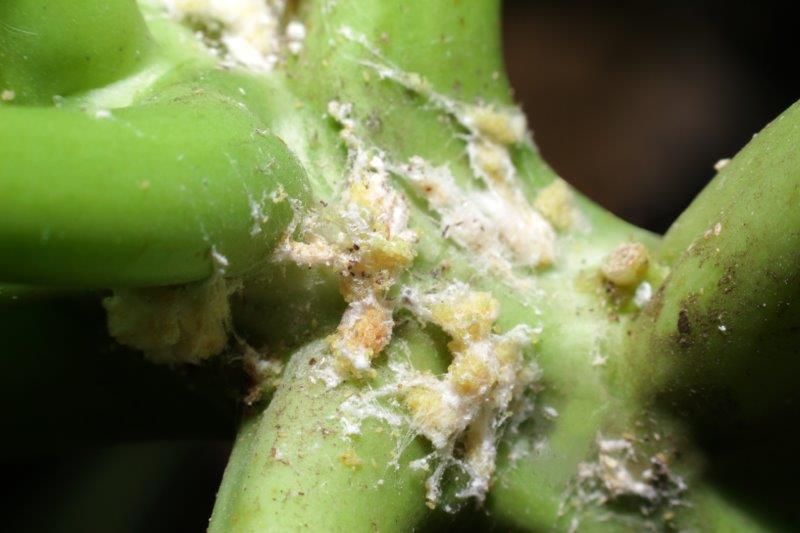Exclusive to most greenhouses and warm, humid climates, and southern states, mealybugs are one of the most widespread varieties of scale insect found in North America. While mealybugs are most notorious for feeding on sap via leaves and foliage, there are just as many species that feed solely on a host’s stems, twigs, and roots.
Mealybugs are about as big as aphids and generally exhibit shades of pale white, cream, and gray attributed to an exterior layer of wax which gives them their “mealy” appearance.
Though fairly small, many species of mealybug can be easily identified with the naked eye because, as a scale insect, mealybugs share a very distinct crustacean-like body similar to that of a tiny shrimp or crab. There are about 300 known genera of mealybugs each containing an unknown number of species per genus.
How to Get Rid of Mealybugs
- Mealybug Distribution: Widespread in greenhouses and warmer, drier regions throughout the world
- Mealybug Host Plants: Ornamental flowers, fruiting trees, tomatoes, leafy greens, and vegetables
- Mealybug Damage: Curled, wilted, and stunted leaves that have been sucked of their sap
- Mealybug Life Cycle: 90 days
- Mealybug Eggs Per Lifetime: 300-600 eggs
- Mealybug Control: 70% isoprpyl alcohol, pruning, neem oil, dish soap spray, high pressure hose
- Mealybug Predators: Ladybugs, lacewings, spiders, beetles, mealybug destroyer
- Most Common Mealybug in North America: Citrus Mealybug (Planococcus citri)

What Do Mealybugs Look Like?
Unlike many garden insects which can have a diverse array of color, mealybugs are almost exclusively found to be white because of their fibrous and waxy exterior which is said to look like a type of white grain “meal”.
Though small like aphids or spider mites, a mealybug infestation is unmistakable because each of the small, fuzzy white bugs collectively look like an aggressive spreading white and webbed mold.
Even their egg sacs have a similar webbed appearance that can largely help to identify a mealybug infestation. And similar to mold, mealybugs also thrive in the most humid and optimally moist conditions.
Mealybugs Damage

Similar to aphids and spider mites, mealybugs are among one of the many “true” pests in the garden and are swarming sap-suckers that can quickly deplete a host plant of its essential sugars and juices.
An infestation is easy to spot because of the mealybug’s unique waxy white coating and mold-like webbing found beneath the leaves of a host.
The leaves of the host will begin to yellow and curl as the mealybug infestation goes unchecked.
Luckily for growers both indoors and out, the mealybugs themselves are much easier to spot and identify than the signs of potential yellowing and decline of foliage.
What Do Mealybugs Eat?
Depending on the species and region, some mealybugs will only consume the healthy leaves and foliage from a host plant while other species will feed solely on the stems, twigs, and roots.
Due to the largely unknown number of species, mealybugs are not choosy when it comes to infesting a host plant and are well-known to feed indiscriminately on nearly every ornamental flower including rose, gardenia, begonia, coleus, and are particularly damaging to thin-skinned fruits such as stone fruit, tomato, and grapes.
Similar to aphids, mealybugs do not consume the plant itself but, rather, ingest the sugary and nutrient-rich nectar.
Mealybugs Eggs
Similar to their feeding habits, mealybugs will lay their eggs on either the leaves, stems, or twigs of a host plant for a brief 7-14 days until hatching.
A mealybug egg sack looks very similar to spider webbing or aggressively spreading mold without any real definitive shape.
While many insect egg sacs can have a very composed and deliberate form similar to a pod or cocoon, the white webbing of mealybug egg sacs appear as if accidental or spreading like mold.
Mealybug egg sacs will contain anywhere from 100-600 eggs and, once hatched within two weeks, newborn insects will be poised to feed on the host plant.

How to Get Rid of Mealybugs
If possible, move the infested plant away from others and prune the affected areas to physically remove the infestation.
More established plants such as rose bushes and fruiting trees can be easily sprayed with a high pressure hose to dislodge and kill an infestation.
For softer and more tender plants, add about a tablespoon of either neem oil or household dish soap to a liter of water and mix thoroughly before spraying the affected areas. Continue once or twice a week until infestation is gone.
Spraying or gently applying undiluted 70% isopropyl rubbing alcohol is also proven effective to immediately eradicate a mealybug infestation.
Mealybug Treatment

- 70% Isopropyl Alcohol - Lightly apply undiluted alcohol with a cotten swab or spray bottle
- Pyrethrin Spray - Natural chemical extract and pesticide from the genus Chrysanthemum
- Organic Neem Oil Spray - 1 tsp neem oil and 1/4 tsp dish soap to 1 quart water
- Imidacloprid-based Spray - Commercial pesticide popularly used for hardshell pests
- Dish Soap and Water - 2 tbsp to 1 quart water
- High Pressure Hose - Many insecticides are sold to be attached to the end of any common gardening hose for immediate control




